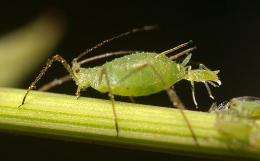August 21, 2012 report
Researchers find evidence of photosynthesis-like process in aphids

(Phys.org) -- In plants, algae and some types of bacteria and fungi, sunlight is converted to chemical energy in a process we all know as photosynthesis; in that process water and carbon dioxide are also converted to oxygen. Now it appears that a type of aphid, a small insect, is able to do something similar, minus the water and carbon dioxide conversion. Researchers at the Sophia Agrobiotech Institute in France, have found that not only do aphids produce carotenoids, but the amount they produce seems to be directly influenced by the amount of sunshine they receive in their daily life. This the authors explain in their paper published in Scientific Reports, suggests the insects might be able to directly convert sunlight to energy, which would make it the only animal able to do so.
Carotenoids are pigments that in most animals are obtained via consumption of other organisms that create it via photosynthesis. Aphids on the other hand are able to synthesize them all by themselves, making them stand out. Researchers aren’t sure why they do so, but many other animals rely on carotenoids to help bolster a strong immunity system. Scientists do know that carotenoids in aphids are responsible for their color. Those with high levels are green, those with very low levels are white, and those in-between are orange.
In this new research the team found that the levels of carotenoids in the aphids appeared to correlate with levels of adenosine triphosphate (ATP), which we all remember from biology class as the way to measure the transfer of energy in living things. The higher the level of carotenoids were the more ATP was present, but more interestingly, when the team moved orange aphids in and out of direct sunlight, levels of carotenoids and ATP rose and sunk, suggesting the insect was getting energy directly through such exposure. They also crushed some of the orange bugs so as to purify their carotenoids as part of their experiment in trying to show that it was the pigments that were involved in absorbing sunlight and converting it to energy.
None of this proves that aphids really can convert sunlight to energy, of course, it merely offers strong evidence. To prove it, researchers will have to dream up more experiments that will help rule out other possibilities, such as genetically engineering aphids that produce no carotenoids at all to see what happens.
More information: Light- induced electron transfer and ATP synthesis in a carotene synthesizing insect, Scientific Reports 2, Article number: 579 doi:10.1038/srep00579
Abstract
A singular adaptive phenotype of a parthenogenetic insect species (Acyrthosiphon pisum) was selected in cold conditions and is characterized by a remarkable apparition of a greenish colour. The aphid pigments involve carotenoid genes well defined in chloroplasts and cyanobacteria and amazingly present in the aphid genome, likely by lateral transfer during evolution. The abundant carotenoid synthesis in aphids suggests strongly that a major and unknown physiological role is related to these compounds beyond their canonical anti-oxidant properties. We report here that the capture of light energy in living aphids results in the photo induced electron transfer from excited chromophores to acceptor molecules. The redox potentials of molecules involved in this process would be compatible with the reduction of the NAD+ coenzyme. This appears as an archaic photosynthetic system consisting of photo-emitted electrons that are in fine funnelled into the mitochondrial reducing power in order to synthesize ATP molecules.
Journal information: Scientific Reports
© 2012 Phys.org

















